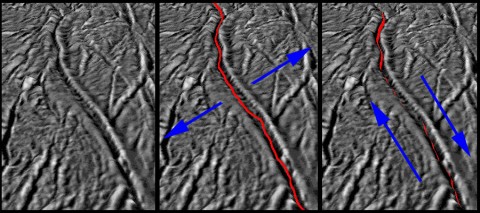Written by Jia-Rui C. Cook
NASA’s Jet Propulsion Laboratory
 Pasadena, CA – Images from NASA’s Cassini spacecraft have, for the first time, enabled scientists to correlate the spraying of jets of water vapor from fissures on Saturn’s moon Enceladus with the way Saturn’s gravity stretches and stresses the fissures. The result is among the Cassini findings presented today at the Lunar and Planetary Science Conference at The Woodlands, Texas.
Pasadena, CA – Images from NASA’s Cassini spacecraft have, for the first time, enabled scientists to correlate the spraying of jets of water vapor from fissures on Saturn’s moon Enceladus with the way Saturn’s gravity stretches and stresses the fissures. The result is among the Cassini findings presented today at the Lunar and Planetary Science Conference at The Woodlands, Texas.
“This new work gives scientists insight into the mechanics of these picturesque jets at Enceladus and shows that Saturn really stresses Enceladus,” said Terry Hurford, a Cassini associate based at NASA Goddard Space Flight Center in Greenbelt, MD.

Hurford and colleagues suggested a few years ago that tidal pulls from Saturn’s gravity could explain the existence of the jets, but they had not been able to correlate specific jets with calculated stresses until now. They studied the jets emerging from the warmest regions within the tiger stripes Baghdad Sulcus and Damascus Sulcus.
The scientists found that the greatest stresses pulling apart the tiger stripes, occurred right after Enceladus made its closest approach to Saturn in its orbit. The scientists found that Saturn’s gravitational pull could also deform the fissure by making one side move relative to the other side. That kind of deformation seemed to occur quite often during Enceladus’ orbit around the planet, even when Enceladus was very far away.
The finding suggests that a large reservoir of liquid water – a global or local ocean – would be necessary to allow Enceladus to flex enough to generate stresses great enough to deform the surface, Hurford said. That process would control the timing of the jet eruptions. The finding also suggests that Saturn’s tides create an enormous amount of heat in the area.
The conference will also include a talk presenting highlights of the Cassini mission by Linda Spilker, Cassini project scientist at NASA’s Jet Propulsion Laboratory, Pasadena, CA. She will present images showing the evolution of an enormous storm that roiled the northern hemisphere of Saturn, the effect of seasonal rain storms on Saturn’s moon Titan, and what Cassini will hope to observe in the next few years of its extended mission.
The Cassini-Huygens mission is a cooperative project of NASA, the European Space Agency and the Italian Space Agency. NASA’s Jet Propulsion Laboratory in Pasadena manages the mission for the agency’s Science Mission Directorate in Washington. The Cassini orbiter and its two onboard cameras were designed, developed and assembled at JPL. The imaging operations team is based at the Space Science Institute in Boulder, CO. JPL is a division of the California Institute of Technology, Pasadena.
For more information about the Cassini-Huygens mission, visit http://saturn.jpl.nasa.gov and http://www.nasa.gov/cassini .


